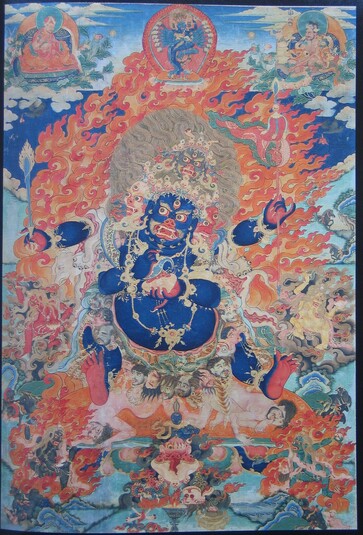
Item: Mahakala (Buddhist Protector) - Chaturmukha (Four-Faced)
| Origin Location | Tibet |
|---|---|
| Date Range | 1700 - 1799 |
| Lineages | Sakya and Buddhist |
| Material | Ground Mineral Pigment on Cotton |
| Collection | Rubin Museum of Art |
Classification: Deity
Appearance: Wrathful
Gender: Male
Mahakala, Chaturmukha (Four-faced Great Black One) associated with the Guhyasamaja Tantra along with the Twenty-five and Fifty Chapter Mahakala Tantras. There are also Nyingma Revealed Treasure Traditions (terma) of Chaturmukha.
According to the Sakya Tradition this form of Mahakala with four faces and four arms is rarely depicted in art and virtually never shown to those who are uninitiated. The early Sakya Teachers devised a simplified form of the deity to be depicted on paintings as a place card-holder for the true image and form which was considered too secret and dangerous to display publicly. The simplified form is that of what has come to be known as Brahmanarupa Mahakala.
"Shri Vajra Chaturmukha Mahakala, the main face and the stacked face are both black, the two on the right and left are dark green. With four arms, the first two right and left hold a curved knife and blood filled skullcup to the heart. The lower right [holds] a sword. The lower left holds upraised a bone garland [of beads]. The brown hair bristles upwards; there are three eyes, bared fangs, lower lip distended, a crown of five dried skulls, a necklace of fifty fresh [heads], a brahmin's cord, bone and snake ornaments. [He] stands in a manner with the right leg bent and the left straight; having an appearance of magnificent wrathfulness. On the right is black Dombini, left green Chandali, front red Rakshasi, behind yellow Singhali." (by Ngorchen Konchog Lhundrup (1497-1557). Lamdre Collection, vol.18, folios 375-398. sGrub Thabs Kun bTus, vol.10., fol. 400-422. Gyu De Kun Tus, vol.18, fol.128-150).
In paintings Chaturmukha Mahakala is typically depicted in his form known as the Accomplishment. In this form he has four faces, four arms and two legs. The main face is blue-black and the right white and the left red. The top face is smokey coloured. The first pair of hands hold a curved knife and a skullcup. The second pair of hands holds a raised sword in the right and a spear in the left. The right leg is bent and the left straight standing atop a prone corpse-like figure. Standing in front, ghoulish in appearance, dynamic in posture, are the four attendant dakinis; Dombini, Chandali, Rakshasi and Singhali Devi - black, red, yellow and green in colour. This is the description for the main form of the deity that appears most often in art.
Jeff Watt 1-2012
Mahakala: Chaturmukha Iconography
Collection of Rubin Museum of Art (RMA): Main Page
Mahakala: Chaturmukha (Four-faced) Main Page
Mahakala: Chaturmukha (Four-faced, Masterworks)
Collection of RMA: Painting Masterworks Page
Collection of Rubin Museum of Art: Mahakala Painting Masterworks
Subject: Protectors (Wisdom) as Ishtadevata (Meditational Deities)
Mahakala: Chaturmukha - Accomplishment
Subject: Red Snout-like Nose (Wrathful Deities)
Collection of Rubin Museum of Art: Mahakala Page
